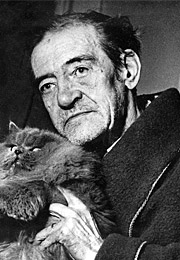


Oil on wood panel
69.2 x 96.5 cm. (27 1/4 x 38 in.)
frame: 99 × 127 × 6.5 cm (39 × 50 × 2 9/16 in.)
L.1988.62.31
Signed lower right: Maurice Utrillo V
[Galerie Pétridès, Paris]; sold to Henry Pearlman, New York, by 1948; Henry and Rose Pearlman Foundation, 1979.
I once traveled to Europe with a dealer who introduced me in Paris to the dealer for Utrillos. I was successful in having this dealer send six or seven Utrillos to his New York…
I once traveled to Europe with a dealer who introduced me in Paris to the dealer for Utrillos. I was successful in having this dealer send six or seven Utrillos to his New York gallery, and tried to help him sell them. I telephoned a friend of mine and had him take one on consignment; he hung it as the main picture in his room, replacing another painting that he had hanging. But he didn’t want to pay the gallery’s asking price, so the dealer rook it back, and my friend put his old painting back up over his fireplace.
About a week later my friend telephoned me to say that he could not stand his old painting anymore and asked me to be the intermediary with the dealer on the price. I told him that financially he was well equipped to pay the price and the dealer had very little margin on it, so he was glad to purchase the Utrillo painting at the dealer’s price.
On my first visit to Europe, just after World War II, a New York dealer brought me into a gallery in Paris that had several Utrillos. I liked one of them and bought it, and the dealer gave me a photograph marked 1917. Subsequently, when this same dealer wrote a book on the Oeuvres of Utrillo, he reproduced the painting, and dated it 1937. When he sold me the painting he had enlarged on the idea that it was an early Utrillo, as these were more in demand and more costly, so I can only believe that his earlier false date was intentional.

Maurice Utrillo (1883-1955)
Utrillo is best known for atmospheric street scenes of Paris rendered in a broadly geometric style. He grew up in Montmartre, where he lived a bohemian lifestyle. His mother was the painter Suzanne Valadon, who had worked as a model for many artists, including Pierre-Auguste Renoir, Henri de Toulouse-Lautrec, and Puvis de Chavannes. At the age of eight, a Spanish painter named Miguel Utrillo y Morlius claimed paternity, but Utrillo’s biological father remains unknown. He was raised by his grandmother and did not show any interest in becoming an artist in his youth; in his late teens, his mother urged him to take up art to combat his dependency on alcohol. He began to paint landscapes around the village of Montmagny, north of Paris, with thickly impastoed paint. His focus on everyday life and predilection for the materiality of paint was in part inspired by artists such as Gustave Courbet and Camille Pissarro. Utrillo then returned to Montmartre, whose streets, churches, shops, and houses would become the major subject of his painting throughout the rest of his life, often presented with a sense of flattened, orderly space and brusque strokes of paint.
Some of Utrillo’s most famous paintings, from around 1909–14, are picturesque yet austere compositions dominated by tonalities of white, which he created by mixing paint with glue, plaster, or even cement. As his health deteriorated, he was no longer able to paint the streets of Paris from direct observation, instead relying on postcards viewed in the studio; his palette became increasingly dark. Despite his difficulties, Utrillo remained prolific, and his reputation increased among collectors and the public from the 1920s onward.